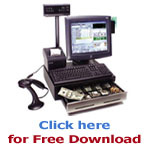How does an RFID system work?
An RFID system consists of a tag made up of a microchip with an antenna, and an interrogator or reader with an antenna. The reader sends out electromagnetic waves. The tag antenna is tuned to receive these waves. A passive RFID tag draws power from the field created by the reader and uses it to power the microchip’s circuits. The chip then modulates the waves that the tag sends back to the reader, which converts the new waves into digital data. For more information on the components of a complete system used in businesses, see Getting Started.
What is the difference between low-, high-, and ultra-high frequencies?
Just as your radio tunes in to different frequencies to hear different channels, RFID tags and readers have to be tuned to the same frequency to communicate. RFID systems use many different frequencies, but generally the most common are low-frequency (around 125 KHz), high-frequency (13.56 MHz) and ultra-high-frequency or UHF (860-960 MHz). Microwave (2.45 GHz) is also used in some applications. Radio waves behave differently at different frequencies, so you have to choose the right frequency for the right application.
How do I know which frequency is right for my application?
Different frequencies have different characteristics that make them more useful for different applications. For instance, low-frequency tags use less power and are better able to penetrate non-metallic substances. They are ideal for scanning objects with high-water content, such as fruit, but their read range is limited to less than a foot (0.33 meter). High-frequency tags work better on objects made of metal and can work around goods with high water content. They have a maximum read range of about three feet (1 meter). UHF frequencies typically offer better range and can transfer data faster than low- and high-frequencies. But they use more power and are less likely to pass through materials. And because they tend to be more “directed,” they require a clear path between the tag and reader. UHF tags might be better for scanning boxes of goods as they pass through a dock door into a warehouse. It is best to work with a knowledgeable consultant, integrator or vendor that can help you choose the right frequency for your application.
Do all countries use the same frequencies?
No. Different countries have allotted different parts of the radio spectrum for RFID, so no single technology optimally satisfies all the requirements of existing and potential markets. The industry has worked diligently to standardize three main RF bands: low frequency (LF), 125 to 134 kHz; high frequency (HF), 13.56 MHz; and ultrahigh frequency (UHF), 860 to 960 MHz. Most countries have assigned the 125 or 134 kHz areas of the spectrum for low-frequency systems, and 13.56 MHz is used around the world for high-frequency systems (with a few exceptions), but UHF systems have only been around since the mid-1990s, and countries have not agreed on a single area of the UHF spectrum for RFID. UHF bandwidth across the European Union ranges from 865 to 868 MHz, with interrogators able to transmit at maximum power (2 watts ERP) at the center of that bandwidth (865.6 to 867.6 MHz). RFID UHF bandwidth in North America ranges from 902 to 928 MHz, with readers able to transmit at maximum power (1 watt ERP) for most of that bandwidth. Australia has allotted the 920 to 926 MHz range for UHF RFID technology. And European transmission channels are restricted to a maximum of 200 kHz in bandwidth, versus 500 kHz in North America. China has approved bandwidth in the 840.25 to 844.75 MHz and 920.25 to 924.75 MHz ranges for UHF tags and interrogators used in that country. Until recently, Japan did not allow any UHF spectrum for RFID, but it is looking to open up the 960 MHz area. Many other devices use the UHF spectrum, so it will take years for all governments to agree on a single UHF band for RFID.
RFID can be used with sensors. Is that true ?
Yes. Some companies are combining RFID tags with sensors that detect and record temperature, movement and even radiation. The technology can also be used in the health-care sector. For instance, Belgium’s University Hospital of Ghent has implemented a system that detects when a patient is having cardiac distress, and sends caregivers an alert indicating the patient’s location.















Primers on RFID (What is RFID? How does it work? What are RFID applications? What are relevant standards? etc) may be found on the RFID Tribe website.
http://www.rfidtribe.org
RFID Tribe is the world’s community for RFID professionals.